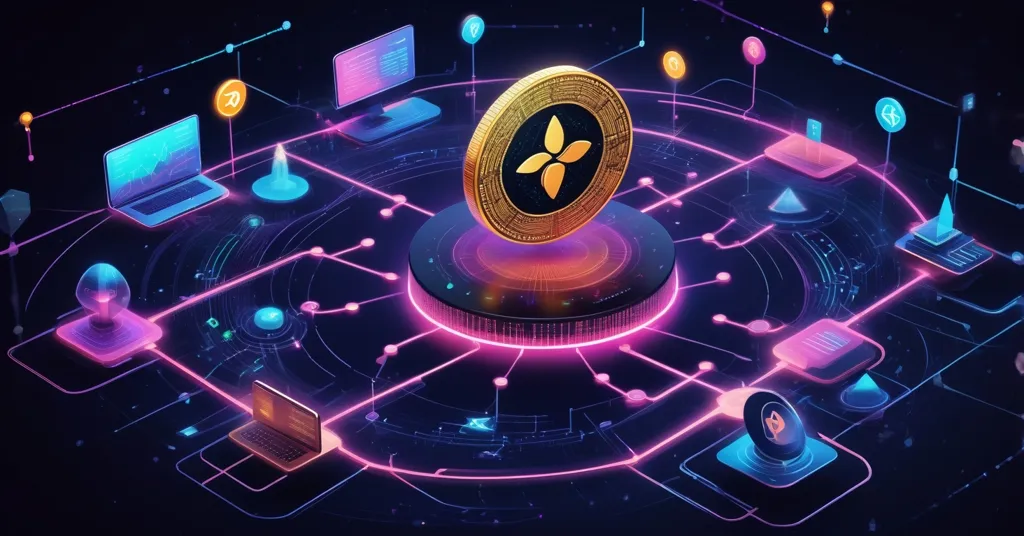Flare’s XRPfi Unleashes DeFi Power for XRP with Smart Contracts in 2025

Flare’s XRPfi: Revolutionizing XRP with DeFi and Smart Contract Power
Has XRP finally found the turbo boost it needs to break free from its limitations and soar into the future of finance? Flare Network’s XRPfi, a decentralized finance (DeFi) ecosystem launched in late September 2025, is making waves by integrating XRP into the world of smart contracts—a realm previously inaccessible due to the constraints of the XRP Ledger. With explosive growth and innovative tools, XRPfi is positioning XRP as a serious contender in the DeFi space, and the numbers are hard to ignore.
- Staggering Growth: Flare’s total value locked (TVL) has surged 40% since the debut of FXRP and risen fivefold year-to-date in 2025.
- DeFi Breakthrough: XRP, lacking native smart contract support, now thrives in DeFi through Flare’s FAssets and protocols like SparkDEX.
- Market Buzz: Increased utility via DeFi is fueling optimism for XRP’s value, though risks remain.
XRP’s Longstanding Hurdle
XRP, the native cryptocurrency of the XRP Ledger, has been a heavyweight in the crypto market for years, often ranking among the top by market cap due to its focus on fast, low-cost cross-border payments. Backed by Ripple’s fintech partnerships, it’s carved out a loyal following. But there’s a glaring issue: the XRP Ledger doesn’t support smart contracts natively. For the uninitiated, smart contracts are self-executing agreements with terms coded directly onto a blockchain, powering most DeFi applications like lending platforms and decentralized exchanges (DEXs). Since the DeFi boom—often called “DeFi Summer”—kicked off on Ethereum in 2020, XRP holders have been stuck on the sidelines, unable to tap into these financial tools while Ethereum users raked in yields. This gap has left XRP largely relegated to payments and speculative trading, missing out on the broader financial revolution. Flare Network is stepping in to change that with XRPfi, a bold attempt to bridge XRP into the DeFi world.
How Flare Bridges the Gap
Flare Network operates as a secondary layer—think of it as a turbocharger bolted onto a car engine—to enhance the capabilities of blockchains like the XRP Ledger that lack smart contract functionality. Through its innovative FAssets system, Flare creates tokenized versions of assets like XRP, dubbed FXRP (Flare-issued XRP). Imagine FXRP as a digital passport for XRP, letting it cross into DeFi territories it couldn’t access before. This tokenized representation allows XRP to interact with smart contract-based protocols, unlocking a suite of financial tools for holders. Since FXRP’s launch in late September 2025, Flare’s TVL—a measure of the total assets locked in its ecosystem—has jumped by 40%, with year-to-date growth hitting an impressive fivefold increase. These figures signal a clear hunger for XRP’s integration into DeFi, as explored in depth in discussions about Flare’s potential to elevate XRP.
What exactly does XRPfi bring to the table? Since May 2025, in partnership with Firelight, Flare has enabled XRP staking. Users can lock up their FXRP on protocols like Sceptre and earn stXRP, a staked version of XRP that generates additional rewards. Staking, for those new to the game, is like parking your crypto in a high-yield savings account to support network operations while earning passive income. Then there’s SparkDEX, a DEX on Flare offering yield farming—lending your crypto to trading pairs to earn interest or tokens—and trading options like spot and leveraged perpetual futures. Flare also supports Tether’s USD₮0 stablecoin natively, meaning no clunky wrapping or bridging is needed to access stable liquidity for DeFi activities. Add token launchpads for new projects and a massive 2.2 billion FLR incentive program boosting annual percentage yields (APY) for liquidity providers, and Flare has built a compelling ecosystem.
User accessibility hasn’t been overlooked either. With integrations like the Xaman wallet for direct FXRP minting, jumping into XRPfi is as easy as a few clicks. Recent partnerships, such as MoreMarkets launching an XRP Flare Account, further streamline access to yield opportunities. As Flare Network has pointed out:
“XRP holders should have access to a wider selection of DeFi-enabled financial tools. For instance, there’s only one AMM live on XRPL [the XRP Ledger], when a holder of XRP – the [fifth] biggest market cap cryptocurrency – should have a suite of options to choose from.”
They’ve hit the nail on the head. With XRP’s massive liquidity and established user base, it’s been underserved for far too long. Flare isn’t just patching a hole; it’s performing open-heart surgery to keep XRP relevant in a smart contract-driven world.
XRPfi vs. BTCfi: Why the Difference?
Flare’s success with XRPfi stands in sharp contrast to slower progress with other non-smart contract assets, like Bitcoin. Efforts to bring Bitcoin into DeFi—often labeled “BTCfi”—have stumbled, hampered by technical challenges and tepid adoption. Bitcoin might be the undisputed king of crypto, but it’s dragging its feet to the DeFi party while XRP sneaks in through the back door. Even Dogecoin, another asset Flare supports, hasn’t seen the same traction as XRPfi. Why the disparity? XRP’s roots in payments and fintech, coupled with a community primed for financial use cases, likely make it a better fit for DeFi than Bitcoin’s store-of-value maximalists or meme coin speculators. Flare’s aggressive incentives and user-friendly onramps, like Xaman wallet integration, have also played a key role in driving XRPfi’s adoption where BTCfi lags.
That said, let’s not crown XRPfi the ultimate victor just yet. Bitcoin remains the gold standard for decentralization, privacy, and disrupting fiat systems. XRPfi’s innovation is a welcome step for altcoins, but it doesn’t eclipse Bitcoin’s role as the bedrock of this financial revolution. Flare’s tech may yet evolve to crack the BTCfi puzzle, but for now, XRP seems to have found a unique sweet spot.
Market Implications: Boom or Bust?
Could XRPfi be the key to unshackling XRP from its speculative rut and regulatory chains? Sentiment in the community is buzzing with optimism, with many pointing to rising DeFi utility as a driver for XRP’s value. More staking, liquidity pools, and trading activity mean more demand for XRP as users lock it up in Flare’s ecosystem. If TVL continues to climb—and with partnerships and incentives in place, there’s little reason to think it won’t—XRP could see a tangible boost. But let’s cut the crap: no amount of DeFi wizardry erases XRP’s baggage. Ripple’s ongoing legal tussle with the SEC is a sledgehammer waiting to drop, and regulatory uncertainty could dampen even the most promising tech. Plus, the broader crypto market is a fickle beast—TVL growth today doesn’t guarantee moonshots tomorrow. We’re not here to peddle baseless price predictions or play crystal ball gazers. Utility matters, but it’s not a magic bullet.
There are other risks to chew on. Tokenizing XRP into FXRP relies on cross-chain bridges, a notorious weak point in DeFi. Past hacks—like Wormhole or Ronin, where millions were siphoned due to bridge vulnerabilities—serve as a grim reminder that security isn’t guaranteed. Will the XRP community, often focused on payments or holding for the next pump, fully embrace DeFi’s learning curve? And what about competition? Ethereum still reigns as the DeFi titan, and other layer-2 or sidechain solutions could target XRP or similar assets, challenging Flare’s niche. Even Flare’s 2.2 billion FLR incentive program, while lucrative, raises questions about inflationary pressure or token dilution for FLR holders. Hype is one thing; sustainability is another.
The Bigger Picture for Crypto
Flare’s XRPfi isn’t just a win for XRP holders—it’s a proof of concept that older blockchains can adapt and thrive in the DeFi era. This aligns with the core ethos of decentralization: breaking free from centralized financial systems and giving power back to users. XRPfi challenges the notion that non-smart contract assets are relics, showing how innovation can disrupt stagnation. Sure, Bitcoin remains the ultimate middle finger to the status quo, championing freedom and privacy with unmatched resilience. But altcoins and protocols like Flare have a role to play, filling niches Bitcoin doesn’t—and perhaps shouldn’t—tackle. If XRPfi sustains its momentum, could it inspire similar leaps for other assets? Or might the XRP Ledger itself pivot to native smart contracts, reducing reliance on Flare? And let’s play devil’s advocate: is this surge a temporary fad fueled by incentives, or a genuine shift in XRP’s trajectory? The early indicators are encouraging, but only time will reveal if XRPfi truly makes XRP fly.
Key Takeaways and Questions on XRPfi’s Rise
- What is XRPfi, and why should XRP holders care?
XRPfi is Flare Network’s DeFi ecosystem, enabling XRP to interact with smart contract-based tools like staking and trading, offering holders new ways to earn and engage beyond the XRP Ledger’s limits. - How has Flare Network transformed XRP’s utility in 2025?
By introducing FXRP and FAssets, Flare has driven a 40% TVL increase since September 2025 and a fivefold rise year-to-date, turning XRP into a versatile DeFi asset. - What specific DeFi features does Flare offer for XRP?
Flare provides staking with stXRP on Sceptre, yield farming and trading via SparkDEX, native USD₮0 stablecoin support, and a 2.2 billion FLR incentive program for liquidity providers. - Does XRPfi guarantee a price surge for XRP?
While DeFi utility could boost demand and value, external risks like Ripple’s SEC battle and market volatility mean there’s no sure thing—hype doesn’t always translate to price gains. - Why is XRPfi outpacing Bitcoin’s DeFi efforts, and can Flare repeat this success?
XRPfi’s rapid growth stems from XRP’s payment-focused community and Flare’s user-friendly tools, unlike Bitcoin’s slower BTCfi adoption tied to cultural and technical hurdles; Flare’s tech holds potential for other assets, but each faces unique challenges.



